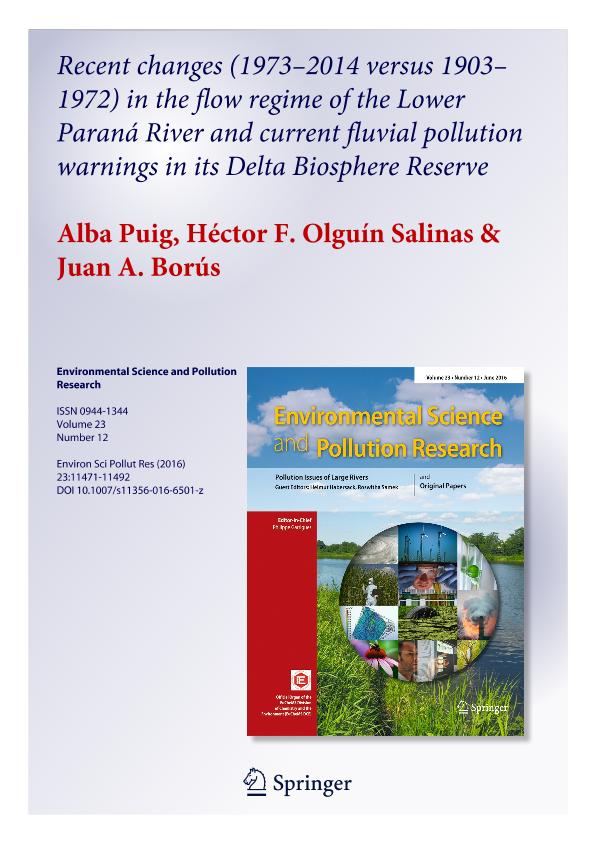Artículo
Recent changes (1973-2014 versus 1903-1972) in the flow regime of the Lower Paraná River and current fluvial pollution warnings in its Delta Biosphere Reserve
Fecha de publicación:
04/2016
Editorial:
Springer Heidelberg
Revista:
Environmental Science and Pollution Research
ISSN:
0944-1344
e-ISSN:
1614-7499
Idioma:
Inglés
Tipo de recurso:
Artículo publicado
Clasificación temática:
Resumen
Alterations in flow regimes of large rivers may originate or increase risks to ecosystems and humans. The Paraná River basin (South America) undergoes human pressures (e.g., heavy damming in the upper basin, deforestation, and mixed pollution) that may affect the water quantity and quality of its terminal Delta (Argentina). In this study, after applying univariate and multivariate change-point detection and trend analyses to the daily data series of flows incoming to the Delta (Paraná-Santa Fe section), flow characteristics were compared by Indicators of Hydrologic Alteration (IHA) and Environmental Flow Components (EFC). Some flood characteristics were also compared from hydrometric levels in the middle Delta (San Pedro station). Chemical and microbiological water variables in the main rivers of the BParaná Delta^ Biosphere Reserve were examined during two extreme hydrologic years (October 2008 to July 2010) to detect potential risk factors in association with hydrologic conditions. In the Lower Paraná River, a historical period (1903–1972) and two more altered periods (1973–1999 wet period and 2000–2014 dry period) were identified. Flow duration curves evidenced different changes in both altered periods, reflecting the joint effect of climatic variability and human influence. The most evident alterations in the flow regime were the lack of record of the extreme-low-flow component, the attenuation of monthly flow seasonality, and the increase in the number of reversals (dry period) and in the variability of maximum and minimum flow dates. These alterations are consistent with the monthly and daily flow regulation by upstream dams evidenced by available data from the current dry period. In the middle Delta, the marked monthly seasonality in flood days decreased only in the wet period. The proportion between the number of flood days exceeding the evacuation level and that of those exceeding the warning level doubled in the wet period but decreased only slightly in the dry period. In the Delta Reserve rivers, concentrations of Escherichia coli, cadmium, lead, iron, manganese, and ammonium exceeded guideline levels under a severe drought and a dispersal of cyanobacteria appeared under a high-flow pulse in La Niña year. The ammonium concentration exceeded the level for human drink with the overbanking flood stage in El Niño year. These occasional detections pose a potential risk to the aquatic life and, especially, to the inhabitants of the Reserve. Flow duration curves, IHA, and EFC are useful tools to evaluate trends or changes of ecological and social relevance in flow regime characteristics.
Archivos asociados
Licencia
Identificadores
Colecciones
Articulos(MACNBR)
Articulos de MUSEO ARG.DE CS.NAT "BERNARDINO RIVADAVIA"
Articulos de MUSEO ARG.DE CS.NAT "BERNARDINO RIVADAVIA"
Citación
Puig, Alba; Olguin Salinas, Hector; Borús, Juan A.; Recent changes (1973-2014 versus 1903-1972) in the flow regime of the Lower Paraná River and current fluvial pollution warnings in its Delta Biosphere Reserve; Springer Heidelberg; Environmental Science and Pollution Research; 23; 12; 4-2016; 11471-11492
Compartir
Altmétricas




